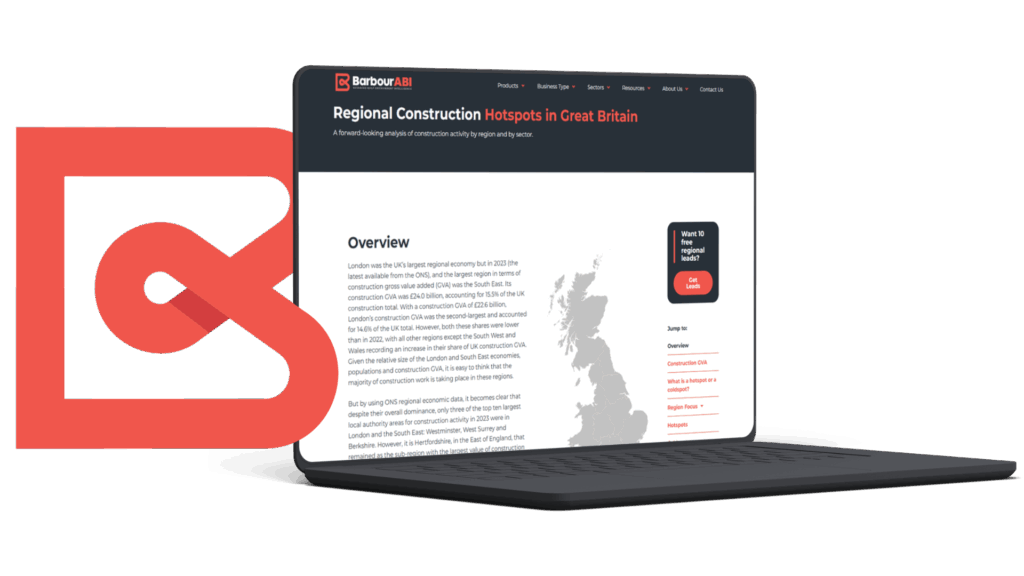The Case for Marketing Investment in the Built Environment
A report, event, and ongoing industry-wide campaign led by Barbour ABI, in partnership with Futurebuild and the C&BE Network to promote increased marketing spend within the built environment to tackle the problems that the industry is facing through increased budgets, collaboration, and increased use of construction technology.

Section 1
Barriers to success –
Understanding our current position
Our survey asked marketers everything from how marketing is perceived in their business to where they see the industry in five years. We wanted to uncover the biggest opportunities and challenges they face, and whether they feel empowered to influence industry perceptions.
Construction is still viewed as ageing, slow to change, and unattractive to young talent. Yet, as older workers retire and digital natives enter, we have a rare chance to reshape the industry’s image. With demand soon to outstrip supply, young workers can benefit. And those who harness new tech (whether that is in marketing themselves or in new product innovation) can massively profit and influence others to follow.
But to engage these skilled and entrepreneurial talents, marketing must first make this potential future feel real. That will require financial backing from C-suites for brand building and from government for education schemes. Marketing must be central to strategy for this to succeed. Are enough marketers currently feeling supported enough to achieve these goals? Do they have enough resource to build brand or are they stuck in the relentless chase for more leads?
In our survey we wanted to engage all points of the spectrum: businesses with huge turnover but little marketing spend, and small firms where marketers are absolutely vital to success.
We had 90 respondents to our survey. 85% of respondents were manager level or above (52% at Head of Department, Director, or Founder/CEO). Respondents spanned the built environment: product manufacturers (35%) formed the largest group, followed by consultants, contractors, subcontractors, architects, and developers (48%). The final 18% fell into other categories. 66% were SMEs (<£50m turnover) with 20% major sized businesses and the rest not revealing business size
So—where are we as an industry, and how did we get here?
Marketing is seen as a cost by a large number of businesses still
Only 55% of respondents feel like their marketing is seen as investment by their business. It seems that the old adage that marketing is the first thing to be cut when times are hard is still true for almost half of businesses.
Business leaders must understand that marketing spend has to go beyond lead generation and paid media spend. Building brand today pays tenfold in the future. Brand size is the number one factor in defining campaign success. You’re making your life easier tomorrow for every campaign when you build your brand today. 95% of your buyers and future workers aren’t in the market right now. You must be top of mind when they come calling, not just when you’re desperate to reel them in.
Is Marketing Seen as a Cost or an Investment at your business?
Biggest blockers to success
Marketing teams are resource-poor, but this is often a choice.
Limited resources, small budgets and feeling like the industry is stacked against you; these problems certainly aren’t industry-specific to construction. However, based on our findings, it does seem like this problem is often a choice that could be rectified in construction.
Our analysis shows that there wasn’t a great correlation between turnover size and the size of marketing teams or budgets. For instance, we heard from businesses with £50m+ turnover with an 11+ strong marketing team… and we heard from businesses of the same size with a single person marketing “team”.
Leadership advocacy was the strongest predictor of investment, not pure financial capacity. The leaders who see marketing as a strategic investment consistently have larger teams, bigger budgets and higher brand spend.
Therefore, educating and influencing leadership to spend more on marketing in specific areas could be the biggest key to unlocking the future of this industry.
Short Termism – The Long and the Short
As many marketers will know, the seminal The Long and Short of It by Peter Field and Les Binet recommended (with great empirical evidence to back this approach) a 60/40 split in marketing budgets: 60% in long-term brand building and 40% going into short-term sales activation.
To put it simply: this isn’t happening in construction. A shocking 31% reported less than 10% of their annual budget is being spent on brand. Only 11% of our sample reported spending 50%+. Even over a third of the respondents who feel that marketing is central to strategy at their company revealed that less than 30% of their budget is spent on brand.
Over 70% of the firms whose leadership are neutral or sceptical towards marketing keep their brand budget spend below 20%.
As we will see below, this lack of a long-term strategy is also borne out in how most businesses still win work.
% Of marketing budget spent on brand
What has the biggest impact on winning work for your business?
Networking is still the biggest work winner
When asked what has the biggest impact on winning new work for businesses, it was networking and relationships that came out on top.
Whilst relationship building of course plays a massive part in winning work and building successful allyship and brand ambassadors across the industry, it could be worrying that this is the most heavily selected topic. It suggests an industry where work is still won as repeat business and handshake deals. Again, this very much has its place, but it isn’t a strategy for expanding your client base widely or improving the image of construction as a “boys club” where you have to know the right people to get anywhere.
People need more people
When given an increase in budget anywhere that they could want, a huge amount more respondents opted for increasing the size of their team above any other option.
The second most popular choice was more staff training. The signs here are obvious: Teams feel understaffed and are taking on more roles than their natural remit.
This may not be a surprise, but it suggests a large group of teams struggling to keep their heads above water, as opposed to thriving. This perhaps explains why we saw the answers that we did to our next question.
If budget was no factor, what would you do first?
Is construction better or worse than other industries at marketing?
Nobody thinks construction is doing a great job at marketing
Not a single respondent perceived construction as significantly better at marketing than other industries. Only 10% have the confidence to even say that we’re a little better.
Almost two-thirds think that we’re actively worse than other industries. How can we improve the perception of our industry when only 1 in 10 of those who market our industry think that we’re actually better than other industries in our own category?
We need to give our marketers a reason to shout with pride about where they work. We need an industry that will share successes and talk more openly, rather than always undercutting and trying to win the cheapest work from one another.
Section 2
Causes for optimism –
How do we harness the passion for better?
We also gave respondents free reign to share their hopes for the future, their concerns and where they realistically see the industry in five years time.
Generally speaking, people’s optimism revolved around success in 3 key categories:
- Social values and ESG
- Education
- Community building and changing the story of construction
If we want construction to attract wider talent, we need governmental help to deliver education schemes to young workers. But this will be useless without building a better image of the industry to drive apprenticeship signups and avoid high dropout rates.
We need to build an industry that people across cultures, gender, locations and classes all feel that they are accepted in and that they have the opportunity to build fulfilling, profitable careers in.
Unsurprisingly, AI also frequently appeared across responses. Given the wish for more staff across the industry, it would appear that many respondents feel there can be major gains to be had from harnessing AI to lighten their own workload in the areas that fall outside their comfort zone.
94% of respondents believe that AI will impact the industry in the next 5 years. However, around 20% have no plans to use AI in their own business. This fifth of the industry must be crystal clear in their strategy and objectives in refusing to use AI. If not, they risk being stuck in the past and left behind by competitors that become more efficient or more attractive to clients and investors.
However, a word of caution must be raised around using AI. We are still in the early stages of adoption, and poor use of AI won’t do anything to improve client experience, work winning or industry perceptions.
As with all marketing, before you jump into using AI, ask yourself if what you’re creating is worth putting into the world, or whether you’re just doing it because it feels like what you “should” be doing.
It is imperative that we keep up to speed with new technologies. But we can’t allow business to get caught in the trap of thinking a quick prompt in ChatGPT will remove the need for a marketing team.
The good news for the industry is that if we follow these suggestions, our perception from outside can almost certainly only get better. And if we can entice the first crop of young, skilled workers into the industry, then the tide can truly be turned once they are making money in an engaging industry.
But to implement any of these changes, we need support from the top.
Section 3
Leadership and Industry Culture
Let’s finish by returning to individual businesses and their corporate strategy. We can’t achieve anything as a macro unit without micro changes in each business.
Almost half of our respondents see themselves as being very central to corporate strategy. Another third believe they are fairly central. So, basically 4 out of 5 respondents feel central to their business’ strategy. This is a good thing. These are the businesses that we need to push for more cooperation and better brand building from. Similarly to the group of businesses who have no plans to use AI, this other 20% will either soon see the need to catch up, or they’ll be left behind.
How central is marketing to corporate strategy?
Senior leadership’s attitude towards marketing
When asked for the biggest challenge facing construction, one respondent put it as: “Trying to keep up with the waves of new technologies, understanding them and implementing them. Running to try and not be left behind”.
We’ve all felt this way at one time or another. But if we run together a bit more often, we’ll be more secure of our position in the field with our companion beside us.
This report is a call for greater brand spend, less short term revenue chasing, less undercutting of one another and more sharing of successes.
But working this way comes with a responsibility that we marketers must accept.
As marketers we know the benefits of brand building and long-term strategic planning. But we can’t expect to just tell our leadership to go read Field and Binet and leave us alone.
We have to prove why this is important, not just for societal purposes but for business ones too. So, if your unsupportive board won’t back you paying for market research or perception surveys, then start small. Implement Net Promoter Score, track your branded searches across time, dig through your customer data to find success stories and case studies to prove your point. Perhaps even suggest brand partnerships with other business leaders that your board are friendly with (if there are any). If they believe that networking is the best way to win work, then meet them halfway on it.
Be brave enough to engage with colleagues at other businesses for ideas and support. If they aren’t direct competitors, you’ll probably be surprised at how willing they could be to help.
We want to build the case for more marketing investment in the built environment. If we’re going to succeed, we have to build it together.
Report Author Bio:

Peter Chesters
Head of Demand Generation, Barbour ABI
Peter has worked for Barbour ABI since March 2019. Having began his career as a copywriter, he moved into marketing in 2020, whilst maintaining a strong passion for writing persuasively to win new clients.
Since embarking upon more marketing training, Peter gained a deep interest in market research and strategy as the backbone of good quality marketing.
As Head of Demand Generation for Barbour ABI, Peter leads the team that develops the strategy and implements the tactics that brings new leads into the business and keeps the brand image strong as friendly experts in construction data.

